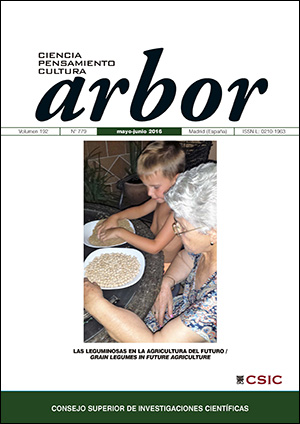Legumes, the poorman’s bread
DOI:
https://doi.org/10.3989/arbor.2016.779n3002Keywords:
Legumes, botany, food, cooking, folklore, geneticsAbstract
Domesticated at the same time as the first cereals and other carbohydrate-rich crops, legumes have maintained close ties with these in all aspects of human life: in the land, traditions, and as food for man or animal feed. However, in modern farming they are only considered to be second class crops, in spite of continuous calls for their use in balanced diets and in crop rotations to increase soil fertility by fixing atmospheric nitrogen, avoiding excess use of synthetic fertilizers. Because of their high protein content they were known as “the poorman’s meat”. Moreover, their ability to fertilize soil was greatly valued by ancient agronomists since Greek and Roman times. Rather than focusing on the technical aspects of legumes, the present article considers the relationship between man and legumes from different perspectives, including their role in the History of Science, being protagonists of fundamental studies such as those carried out by Mendel, Galton and Johannsen, as well as the first description of a QTL.
Downloads
References
Blaringhem, L. (1919). Les problemas de l’Hérédité expérimentale. Paris: Ernest Flammarion, Éditeur.
Cubero, J. I. (2013). Introducción a la Mejora Genética Vegetal (3.ª ed.). Madrid: Paraninfo/Mundi Prensa.
Cubero, J. I. (2016, en prensa). Historia General de la Agricultura. Córdoba: Almuzara.
Cubero, J. I. y Moreno, M. T. (eds.) (1983). Leguminosas de grano. Madrid: MundiPrensa.
Darby, W. J., Ghalioungui, P. y Grivetti, L. (1977). Food: the gift of Osiris. Londres: Academic Press.
de Haro, A. (1983). La calidad nutritiva de las leguminosas de grano y su control genético. En Cubero, J. I, y Moreno, M. T. (eds.) Leguminosas de grano. Madrid: MundiPrensa, pp. 211-247. PMid:6417655 PMCid:PMC390082
Srb, A. M., Owen, R. D. y Edgar, R. S. (1968). Genética general. Barcelona: Ediciones Omega.
Font Quer, P. (1962). Plantas medicinales: el Dioscórides renovado. Barcelona: Labor.
Keynes, M., Edwards, A. W. F. y Peel, R. (eds.) (2005). A Century of Mendelism in Human Genetics. Londres: The Galton Institute / CRC Press.
Nadal, S., Moreno, M. T. y Cubero, J. I. (2004). Las leguminosas grano en la agricultura moderna. Madrid: MundiPrensa.
Orive R. y Temprano, F. (1983). Simbiosis Rhizobium-leguminosa. En Cubero, J. I. y Moreno, M.T. (eds.) Leguminosas de grano. Madrid: MundiPrensa, pp. 69-94.
Pérez de la Vega, M., Torres, A. M., Cubero, J. I. y Kole, Ch. (eds.) (2012). Genetics, Genomics and Breeding of Cool Season Grain Legumes. Enfield, N.H., USA: CRC Press.
Polhill, R. M. y Raven, P. H. (1981). Advances in Legume Systematics. Kew, Inglaterra: Royal Botanical Garden.
Sánchez-Monge Parellada, E. (1972). Genética (4.ª ed). Madrid: Labor.
Published
How to Cite
Issue
Section
License
Copyright (c) 2016 Consejo Superior de Investigaciones Científicas (CSIC)

This work is licensed under a Creative Commons Attribution 4.0 International License.
© CSIC. Manuscripts published in both the printed and online versions of this Journal are the property of Consejo Superior de Investigaciones Científicas, and quoting this source is a requirement for any partial or full reproduction.
All contents of this electronic edition, except where otherwise noted, are distributed under a “Creative Commons Attribution 4.0 International” (CC BY 4.0) License. You may read the basic information and the legal text of the license. The indication of the CC BY 4.0 License must be expressly stated in this way when necessary.
Self-archiving in repositories, personal webpages or similar, of any version other than the published by the Editor, is not allowed.














